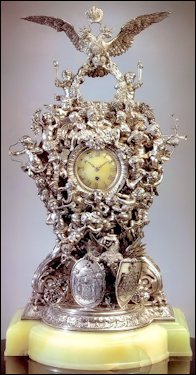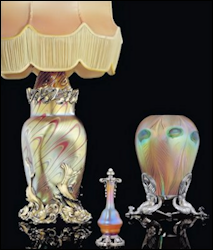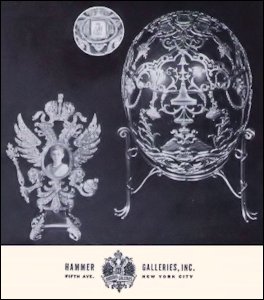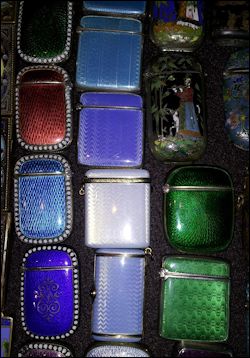
Grand Duke Vladimir (1847-1909)
(Wiki)

Third Imperial Easter Egg by Fabergé
(Courtesy Wartski)
First of all, finding this information is like finding a needle in a hay stack – or real luck of researchers. We looked through a document in the Russian State Historical Archive (RGIA) hoping to find material for an ongoing research topic, the British firm of Maples Furniture:
О заказе и приобретении разных вещей для комнат Их Высочеств как в СПб. Так и в ЦС
1885 год
Fund 528, inventory 1, file 582
About the order and purchase of different objects for Their Highnesses’ rooms in St. Petersburg and Tsarskoye Selo Palaces, 1885
Управл. Конт.
4 мая 1887
N 367
Милостивый Государь Николай Степанович (Петров)!
По поручению ВК Владимира Александровича заказано было ювелиру Фаберже пасхальное яйцо с часами, подставки в стиле Людовика XVI.
Яйцо это по исполнению доставлено Государю Императору.
Ныне Фаберже доставил счет в сумме 2 160 р, который Его Императорское Высочество поручил мне препроводить к Вашему Превосходительству.
М. Соловьев
Sir Nikolai Stepanovich [Petrov]
By order of H.I.H. Grand Duke Vladimir Alexandrovich an Easter egg with a clock and a stand in the style of Louis XVI was commissioned to the jeweler Fabergé. This egg is finished and was delivered to the Emperor. Today Fabergé sent an invoice of 2,160 rubles which H.I.H. commanded me to send to Your excellence. M. Solovyev


Alexander III Portraits Egg and Invoice
(Courtesy Hillwood Estate, Museum & Gardens; Fabergé,
Proler and Skurlov, Imperial Fabergé Eggs, 1997, 123)


Folding Miniature Frame
Provenance: Prince Dimitri, Grandson of Empress Maria Feodorovna. Bought by Wartski for 420 Guineas.
(Christie’s London, March 28, 1961, Lot 151)

(Snowman, A. Kenneth, Carl Fabergé, Goldsmith to the Imperial Court of Russia, 1979, 56)

Last Known Photograph of the Surprise,
Price Realized SFr 38,000
(Christie’s Geneva, May 12, 1980, Lot 283)
- A folding screen with six frames and ten sapphires fits perfectly the description in the Fabergé invoice. Like the egg, the object is signed by Mikhail Perkhin, Fabergé’s head workmaster active from 1886 until his death in 1903, and has the assay mark of the city of St. Petersburg before 1899. The portraits of Emperor Alexander III are missing. Are they still with descendants of Empress Maria Feodorovna?
- The auction catalog provenance also fits perfectly. Prince Dimitri (1901-1980), who in 1961 sold the object at Christie’s London, was the 4th son of Grand Duchess Xenia Alexandrovna, who was the 1st daughter of Maria Feodorovna and Alexander III. The 1961 catalog states the object was a gift from Nicholas II to Maria Fedorovna in 1894 (based on the revised timeline it was an Easter 1896 gift). Lowes and McCanless in Fabergé Eggs: A Retrospective Encyclopedia, 2001, 46, point out this frame was shown at the 1935 London Exhibition of Russian Art, item 559, case III – Ornaments by Fabergé. The description reads: “The Emperor Alexander. Six miniatures in different uniforms by Zehngraf. Lent by H.I.H. The Grand Duchess Xenia of Russia, Windsor.”
- The sapphires match the deep royal blue of the egg’s champlevé enamel and the red gold of the object is a match to the red gold of the elaborate patterns engraved within the enamel.
- The Hillwood Museum staff tested a replica of the surprise inside their egg. The replica was built using the dimensions and the illustrations mentioned in the publications. It fitted the inside of the egg so perfectly that it was barely able to move within its confines. The four top corners of the folded screen match exactly the four marks on the velvet lining in the inside of the top portion of the egg.
It is our hope this new information will reunite the surprise with the 1896 Alexander III Portraits Egg in the Post Collection. We would like to thank the staff at Hillwood Museum for their very kind and generous cooperation, Kieran McCarthy at Wartski who supported our research, and Annemiek Wintraecken and Christel McCanless for their indomitable and continued support.


1909 Imperial Standart Egg and the Imperial Yacht Standart
(Courtesy Muntian, Faberge Easter Eggs, 2003, 51+ 54)

DOWNLOAD A LARGER VIEW HERE
Ledger Discovery, Detail and Specifications of Egg Sale
(Courtesy Tatiana Muntian)
Therefore, the 1914 Mosaic Egg costing 28,300 r. was the most expensive Imperial Easter Egg ever made followed by:
- The 1914 Catherine the Great Egg at 26,800 r.
- The 1913 Winter Egg at 24,600 r.
- The 1912 Napoleonic Egg at 22,300 r.
Before this new publication, the Winter Egg was thought to have been the most expensive Imperial Easter Egg.

1914 Catherine the Great Egg (MF), the 1894 Renaissance Egg (MF),
the 1912 Napoleonic Egg (MF), Photograph ca. 1927-1930
(Courtesy Tatiana Muntian)

1915 Red Cross Portraits Egg (MF)
(Courtesy Tatiana Muntian)
![Ranking of the Cost for the First 12 [sic] Imperial Easter Eggs (Pейтинг первых 12-ти императорских пасхальных яиц по стоимости) (Courtesy Fabergé Museum, St. Petersburg)](http://fabergeresearch.com/wp-content/uploads/2016/11/winter14nl15.jpg)
Ranking of the Cost for the First 12 [sic] Imperial Easter Eggs (Pейтинг первых 12-ти императорских пасхальных яиц по стоимости)
(Courtesy Fabergé Museum, St. Petersburg)
| 1. | Mosaic Egg (1914, AF) | 28,300 r. | Colonnade Egg (1910, AF) (bold = not on chart) | 11,600 r. | ||
| 2. | Catherine the Great Egg (1914, MF) | 26,800 r. | 13. | Alexander III Commemorative Egg (1909, MF) | 11,200 r. | |
| 3. | Winter Egg (1913, MF) | 24,600 r. | 14. | Peter the Great Egg (1903, AF) | 9,760 r. | |
| 4. | Napoleonic Egg (1912, MF) | 22,300 r. | 15. | Love Trophies Egg (1907, MF) | 9,700 r. | |
| 5. | Romanov Tercentenary Egg (1913, AF) | 21,300 r. | 16. | Clover Leaf Egg (1902, AF) | 8,750 r. | |
| 6. | 15th Anniversary Egg (1911, AF) | 16,600 r. | 17. | Peacock Egg (1908, MF) | 8,300 r. | |
| 7. | Tsarevich Egg (1912, MF) (should be AF) | 15,800 r. | 18. | Rose Trellis Egg (1907, AF) | 8,300 r. | |
| 8. | Alexander III Equestrian Egg (1910, MF) | 14,700 r. | 19. | Royal Danish Egg (1903, MF) (still missing in 2015) | 7,535 r. | |
| 9. | Bay Tree Egg (1911, MF) | 12,800 r. | 20. | Swan Egg (1906, MF) | 7,200 r. | |
| 10. | Standard Yacht Egg (1909, AF) | 12,400 r. | 21. | Trans-Siberian Egg (1900, AF) | 7,000 r. | |
| 11. | Alexander Palace Egg (1908, AF) | 12,300 r. | 22. | Flower Basket Egg (1901, AF) | 6,850 r. | |
| 12. | Moscow Kremlin Egg (1906, AF) | 11,800 r. | Cockerel Egg (1900, MF) | 6,500 r. | ||
| Total: | 219,700 r. | Empire Nephrite Egg (1902, MF) (still missing in 2015) | 6,000 r. | |||
| Gatchina Palace (1901, MF) | 5,000 r. | |||||
| Red Cross Portraits Egg (1915, MF) | 3,875 r. | |||||
| Red Cross Triptych Egg (1915, AF) | 3,600 r. | |||||
| Total: | 121,170 r. | |||||
| Correction on #7 changes the total spent for each Empress | ||||||
| Five eggs for Maria Feodorovna (MF) | 101,200 r. | Nine eggs (MF) | 65,310 r. | |||
| Seven eggs for Alexandra Feodorovna (AF) | 118,500 r. | Seven eggs (AF) | 55,860 r. | |||
(Updates are posted in Exhibitions on the Fabergé Research Site)
- November 15, 2014 – May 25, 2015 Bellagio’s Gallery of Fine Art, Las Vegas, Nevada
Fabergé Revealed is the traveling exhibition from the Virginia Museum of Fine Arts, Richmond. - November 25, 2014 – March 1, 2015 Drents Museum, Assen, Netherlands
Valuable Eggs from Imperial Russia from the Liechtenstein Landesmuseum Collection includes the Kelch Apple Blossom Egg. - December 23, 2014 – March 15, 2015 Exhibition Hall of the Assumption Belfry, Moscow Kremlin Museums
Map of the Russian Empire. Exhibition includes the 1900 Trans-Siberian Railway and the 1913 Romanov Tercentenary Easter Eggs by Fabergé. - June 20 – September 27, 2015 Oklahoma City Museum of Art, USA
Fabergé, Jeweler to the Tsars is the traveling exhibition from the Virginia Museum of Fine Arts, Richmond. - Delayed until Spring 2016 Schloss Fasanerie, Eichenzell near Fulda, Germany
Fabergé objects from various Hessian collections will be on view. - April 16 – July 17, 2016 Palace Museum – Meridian Gate, Beijing, China
Virginia Museum of Fine Arts will be the first museum in the United States to exhibit works from its permanent collection when its world-renowned Fabergé collection travels to China.
The 2014 ALVR Winter catalog, Antique Jewelry, Fabergé, and Works of Art, is available on the web, or in hard copy by request.
Raiders of the Lost Art
DVD (now available commercially) includes dramatized reconstructions of some of the biggest events in art history, surrounded by carefully scripted investigations and scholarly talking heads, and all with just a breathy touch of hyperbole – not that any of the stories featured in the six episodes needed any extra drama. (Review in “The Art Newspaper”.) Fabergé Eggs, Episode 2, showcases interviews with Kieran McCarthy of Wartski, Cynthia Coleman Sparke of Bonham’s Auction House, and Toby Faber, author of Fabergé’s Eggs, The Extraordinary Story of the Masterpieces that Outlived an Empire, 2008.
Honoring the Parents of Carl Fabergé
- Pärnu, Estonia, the birthplace of Gustav Fabergé (1814-1893). Five generations of the Fabergé family have been painted by Vello Paluoja, a local artist, and presented to the Society of Pärnu Friends of Fabergé in existence for three years. On January 3, 2015, a monument to Gustav Fabergé was unveiled marking the 200th Anniversary of the founder’s birth.

Statue of Gustav Fabergé, Father of Carl Fabergé
and Independent Researcher Valentin Skurlov
(Courtesy Dr. Skurlov) - A new memorial marker was installed in the Trinitatis Cemetery, Dresden, Germany, in memory of Charlotte Maria Fabergé (1824-1903), mother of Carl Fabergé, by the German-Russian Cultural Institute as part of the “Russian Connections in Dresden” project.
- November 19, 2014 First Anniversary Celebration at the Fabergé Museum, St. Petersburg, Russia

Géza von Habsburg, Ulla Tillander-Godenhielm, Kieran McCarthy, Mark Schaffer,
Members of the St. Petersburg Fabergé Advisory Board
(Courtesy Galina Korneva)

Fabergé Objects Shown in Walk-around Cases by Color and Similarity
(Courtesy of Riana Benko)


Fabergé Museum Showcases
(Courtesy of Riana Benko)
For details of three new books published by the Fabergé Museum see Publications.
- December 7-8, 2014 250th Anniversary of the Hermitage Museum, St. Petersburg, Russia
Three rooms dedicated to Carl Fabergé opened in the General Staff Building of the State Hermitage Museum (Courtesy of Paul Gilbert, Royal Russia News). During the opening ceremonies of the anniversary celebration Vladimir Putin, President of the Russian Federation, presented two Fabergé objects to the museum – the 1902 Rothschild Egg Clock and the Alexander III 25th Wedding Anniversary Clock. Previously owned by Alexander Ivanov and displayed in the Fabergé Museum in Baden-Baden, Germany.

1902 Rothschild Egg Clock Sold
for £9 Million ($18.5 Million),
Fabergé Egg Sale Record.
(Christie’s London, November 28, 2007)

Alexander III 25th Wedding Anniversary
Clock Sold for $1,652,500
(Christie’s New York, April 18, 1996)
- September 19, 2014 New installation opened at the Houston Museum of Natural Science, Texas
With the addition of over 150 new pieces, the Fabergé from a Snowflake to an Iceberg exhibition showcases 500 jeweled treasures from the world-renown McFerrin Collection. The growing collection is in two galleries introduced with a large genealogy wall chart of the Romanov family connected to the Danish and British Royal families. A snowflake symbol with a name indicates an object(s) related to the individual is part of the McFerrin Collection featured in show cases with the same name designations. A portrait gallery near the genealogy chart highlights some of the givers and/or recipients. At present there are no plans to update the 2013 catalogue raisonné written by Dorothy McFerrin and 11 contributors. Recent acquisitions include art nouveau pieces (silver objects combined with glass, a specialty of the Viktor Aarne shop), and a just discovered Fabergé fan bringing the total number of fans in the collection to 12. For more about missing Fabergé fans see Searching for Fabergé.

Lötz Glass Lamp,
Tiffany Favrille Glass Scent Flask
and Vase with Fabergé Mounts
by Viktor Aarne
(Courtesy Christie’s London)
Presenters at the Houston Fab Fest 2014
(Courtesy Michelle Connor)Fab Fest 2014 held at the Houston Museum of Natural Science on December 3, 2014, brought together 50 museum docents and Fabergé enthusiasts for a training session. Master docents, Kris Mills and Nancy Fischer, who attended the Third International Fabergé Symposium in St. Petersburg, Russia, decided to share what they had learned. Topics presented included minerals in the museums’ gem and mineral vault juxta-opposed to McFerrin Fabergé objects, the Third Imperial Egg just found, and Fabergé after the Revolution. Additionally St. Petersburg Power Point talks were shared with the docents – The Legacy of Finnish Workmasters, courtesy of Ulla Tillander-Godenhielm, Caring for Fabergé, courtesy of Carol Aiken, and Windows on Russian Life: Fabergé’s Hardstone Figures, courtesy of Tim Adams, Christel McCanless, and Annemiek Wintraecken. Master docent Pat Hazlett talked about her favorite piece in the McFerrin collection, a “wee” brooch. She has granted permission to publish her essay in the newsletter:

Fabergé Jeweled Gold-Mounted Guilloché
Enamel Brooch
(Courtesy McFerrin Collection)
“Good things come in small packages.”
“Diamonds are a girl’s best friend.”
“Pretty in pink.”
- March 15, 2015 Hillwood Museum, Washington, DC Lecture and Film Screening: Fabergé: A Life Of Its Own
In March 2014, the world of Fabergé research was upended by the exciting new discovery of the lost Third Imperial Easter Egg created by Fabergé in 1887 for Emperor Alexander III. The discovery had a direct impact on Hillwood’s scholarship. Wilfried Zeisler, Hillwood’s curator of 19th century art, shares the fascinating story and other new insights to Hillwood’s collection in a short lecture followed by a screening of Fabergé: A Life of Its Own, a feature-documentary telling the epic story of the Fabergé name and its later commercial exploitation. (Courtesy Press Release, Hillwood Museum)
- Virginia Museum of Fine Arts
The traveling exhibition of 238 objects from the Pratt Collection was shown at the Detroit Institute of Arts, Peabody Essex Museum in Massachusetts, Montreal Museum of Fine Arts, is currently at the Bellagio Gallery of Fine Art in Las Vegas, and then is going to the Oklahoma City Museum of Art, and in 2016 to the Palace Museum, Beijing, China. The Montreal Museum of Fine Arts produced a catalog, Fabulous Fabergé: Jeweller to the Czars. See Publications section of the newsletter.
A small collection of Fabergé objects, including the Imperial Rock Crystal Easter Egg, is on display in the European art galleries, while the VMFA’s Fabergé and Russian Decorative Arts collection is on its international tour. All objects will be shown in the newly designed galleries in late 2016.
English publications by the Fabergé Museum, St. Petersburg, Russia:
Muntyan, Tatyana with V.S. Voronchenko, general editor, Fabergé Masterpieces from the Collection of the Link of Times Collection is a revised soft-bound edition of an over-size slip-cased book published in 2004 under the authorship of Géza von Habsburg. In both editions the history for each of the Fabergé eggs is presented in detail.
Fabergé Museum. St. Petersburg published by the Cultural-Historical Foundation The Link of Times gives a brief introduction to the Shuvalov Palace housing the Vekselberg Collection and introduces the reader to the highlights of the repatriated collection.
Fabergé Museum in St. Petersburg Exhibit Index, 2014, enumerates the contents of the 12 display rooms in the Shuvalov Palace. Each object entry includes the name of the object, location and time in which it was made, workmaster, and material used. There are no illustrations.
In 1947, the Virginia Museum of Fine Arts (VMFA) received the 1912 Imperial Tsesarevich Easter Egg as part of the Lillian Thomas Pratt bequest of Fabergé and Russian decorative arts. Research suggests the egg was bought by Mrs. Pratt between September 1933-May 1934, when entrepreneurs Armand and Victor Hammer sold Russian treasures in 21 traveling department store exhibitions in the USA (for a complete listing see Lowes and McCanless, Fabergé Eggs: A Retrospective Encyclopedia, 2001, 15-16)

(1) Armand Hammer Catalog, ca. 1935
(Courtesy Steve Kirsch)

(2) Early Fabergé Vintage
Photograph
(Courtesy Tatiana Fabergé)

(3) Tsesarevich Egg with Modern Replica Stand in the 2012-2016
Traveling Pratt Collection
(Courtesy Detroit Institute of Arts)

(4) Is There an Egg
for This Stand?
(Courtesy Virginia
Museum of Fine Arts)
- Does the stand (Hammer catalog, ca. 1935) belong to another unidentified or even an existing Fabergé egg?
- Are egg stands marked?
- Are there other mix-ups in Fabergé stands?
- Are there other replica stands? Contact: Editors.
A reader questioned how a photograph frame is said to have a maker’s mark of Agathon Fabergé and be dated ‘circa 1930’, when all genuine Fabergé is normally regarded as pre-revolutionary, i.e., before 1918. The editors asked Dr. Ulla Tillander-Godenhielm, who has been studying Fabergé workmasters since 1980, for an explanation. Her answer:

(1) Camilla, Duchess of Cornwall Wearing
the Queen Victoria Brooch
(Courtesy of Ursula Butschal, Royal Magazin)

(2) Fabergé Spherical Clock
(Courtesy Gray Collection)

(3) Stamp Box from the Paris Collection
(Christie’s London, December 10, 2002)
(3) Dr. Ludmila Bakayutova, Director of the A.S. Popov Central Museum of Communications in St. Petersburg, is gathering details on Fabergé stamp boxes for an e-book. Contact: Editors


Fan with August Holmström Mark, St. Petersburg, before 1899
(Rasmussen, Copenhagen, April 16-May 2, 1985; Courtesy McFerrin Collection)

Fan Box 14¾ in. (37.5 cm) Provenance: Wendell Cherry; Safra Collection,
sold for $156,000 in 2005. Where is the Missing Fan?
(Courtesy Sotheby’s New York)

Empress Alexandra Feodorovna’s Monogram
(Courtesy Sotheby’s New York)






